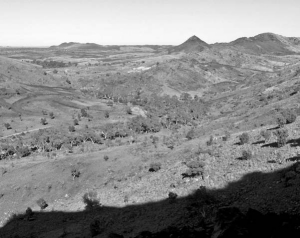VANCOUVER — After a tumultuous year, Moly Mines (MOL-T, MYMNF-O) is back on track, primed to develop both its iron ore and molybdenum projects in Australia with a major investment and financing commitment from a new Chinese partner.
Hanlong Mining Investment, a subsidiary of the privately owned Sichuan Hanlong Group, is providing Moly Mines with US$200 million in equity and debt financing, to pay off the company’s outstanding loans and get the Spinifex Ridge iron ore project up and running. Hanlong is also taking on the responsibility of arranging US$500 million in debt financing to develop the Spinifex Ridge molybdenum project.
The US$200-million debt and equity capital will allow Moly Mines to do two things: repay its outstanding loan, which grew to US$186 million upon its restructuring last month, and develop its iron ore project. The funds will flow from a US$60-million, 10-year term loan and a US$140-million equity issue to Hanlong. In the equity issue, Hanlong is buying 207.1 million shares at A$0.747 apiece. The Chinese company will also receive 35.5 million options exercisable at $1 for three years.
The equity issue represents significant share dilution, as Moly Mines’ share count will more than double. Currently, the company has 124 million shares outstanding, an amount that grew by 42 million just last month when Moly Mines completed a private placement at 75¢ per unit. Each unit comprised a share and a third of a warrant exercisable at $1 for three years. The US$31.5-million placement reduced its outstanding balance with Trust Co. of the West (TCW) to US$134 million.
To develop the small, high-grade Spinifex Ridge iron ore project is only expected to cost US$25 million. The operation would process 1 million tonnes of ore annually from a deposit hosting 6.1 million indicated tonnes grading 58.9% iron. The project also carries 1.2 million inferred tonnes grading 57.2% iron. Its profitability stems from its location just 100 km from Port Hedland — by volume, the world’s second or third-largest iron ore port.
As for the US$500-million commitment, Hanlong has until June 2010 to procure or provide debt financing for development of the Spinifex Ridge moly project. Provided the project finance options vest through to achieving project financing, Hanlong will hold a 54% stake in Moly Mines, on a fully diluted basis. Hanlong and Moly Mines also plan to negotiate a molybdenum offtake agreement.
As recently as early September, Moly Mines was in a tight financial spot, on the hook to repay or restructure a US$150-million bridge loan maturing in late October. The company took on the loan, which carries a harsh annual interest rate of 20%, in August 2008, when things were looking better than bright for its Spinifex Ridge project. Based on a positive feasibility study for a mega-mine churning through 20 million tonnes of ore annually, Moly Mines had secured an offtake agreement and a development permit. It took on the high-interest bridge loan to start ordering equipment, planning to finance the rest of the A$1-billion project and the loan over the following months.
Then the price of moly plummeted from US$30 per lb. to below US$10 per lb., rendering Spinifex Ridge barely economic and the procurement of development financing impossible. The company quickly rescaled the project, completing a new feasibility study on a project with half the annual throughput.
But equipment ordered will arrive, so in the first half of 2009, Moly Mines took delivery of some A$120 million worth of now out-scaled equipment. It was a tight spot, eased only by the recovering price of molybdenum and threatened by the looming bridge loan deadline.
Then the company managed to renegotiate the loan. In late August, TCW granted Moly Mines a one-month extension to the repayment deadline, on the premise that the company would work with the lender during that time to finalize the loan’s restructuring. The proposed terms saw the 20% interest rate fall to 15% and the repayments stretched over a five-year period. The total capital to be repaid, though, climbed to US$186 million and TWC will receive 6 million warrants at a bargain- basement price of A$0.0001, maturing in 10 years.
The Hanlong deal still requires approval from Moly Mines’ shareholders, the Australian foreign investment review board, and Chinese authorities. Moly Mines is also hoping to renegotiate the TCW loan again, based on the new premise that it should be able to repay the debt in its entirety by February 2010, when all approvals are expected to be in place.
On news of the Hanlong deal, Moly Mines’ share price gained 24¢ to reach $1.45, though it settled to $1.28 the next day. The company has a 52-week trading range of 12¢-$1.81.


Be the first to comment on "Moly Mines Welcomes Chinese Partner Hanlong"